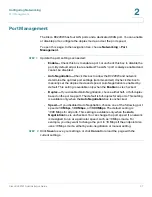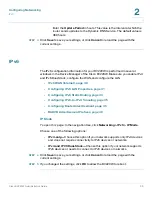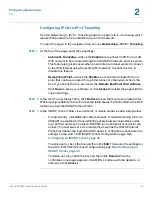
Configuring Networking
IPv6
Cisco RV220W Administration Guide
40
2
IPv6 WAN (Internet)
Use the
IPv6 > IPv6 WAN (Internet)
page to configure your Cisco RV220W in an
IPv4 and IPv6 Dual-Stack network. Before you can configure your IPv6 WAN
settings, you need to enable
IPv4 and IPV6 Dual-Stack
mode on the
IPv6 > IP
Mode
page. See the
“Configuring the IPv4 WAN Settings” section on page 17
.
NOTE
If your service provider requires PPPoE, first configure a PPPoE profile. See
PPPoE
Profiles for Point-to-Point Protocol over Ethernet Connections, page 20
.
To open this page:
In the navigation tree, choose
IPv6 > IPv6 WAN (Internet)
.
STEP 1
In the
WAN (Internet) Address (IPv6)
section, choose the connection type
specified by your service provider.
•
DHCPv6—
Choose this option if your service provider gave you a dynamic
DHCP connection to the Internet, your PC receives its IP address from your
cable or DSL modem. This address can change. No additional settings are
required for this connection type.
•
Static IP—
Choose this option if your service provider gave you a Static IP
connection to the Internet, your Internet Service Provider (ISP) has assigned
you an IP address that does not change. Enter the IP address, mask, default
gateway, and DNS server information. The fields are described in the table
below this step.
STEP 2
If you chose
Static IPv6
as the connection type, enter the
Static IP Address
settings:
•
IPv6 Address—
Enter the IPv6 IP address assigned to your RV220W.
•
IPv6 Prefix Length—
Enter the IPv6 prefix length defined by the ISP. The
IPv6 network (subnet) is identified by the initial bits of the address which are
called the prefix (for example, in the IP address 2001:0DB8:AC10:FE01::,
2001 is the prefix). All hosts in the network have identical initial bits for their
IPv6 address; the number of common initial bits in the network’s addresses
is set in this field.
•
Default IPv6 Gateway—
Enter the default IPv6 gateway address, or the IP
address of the server at the ISP that this RV220W will connect to for
accessing the internet.
•
Primary DNS Server, Secondary DNS Server—
Enter the primary and
secondary DNS server IP addresses on the ISP's IPv6 network. DNS servers
map Internet domain names (for example, www.cisco.com) to IP addresses.









































